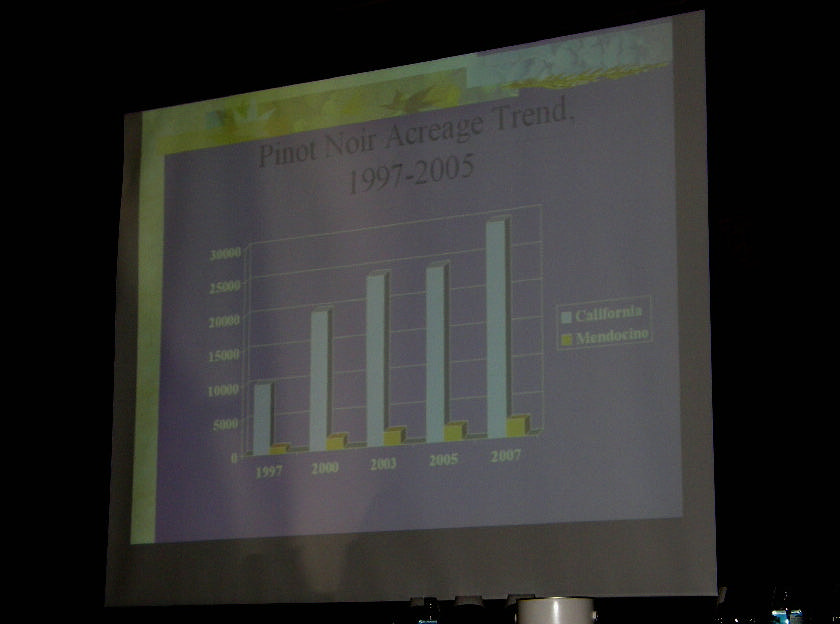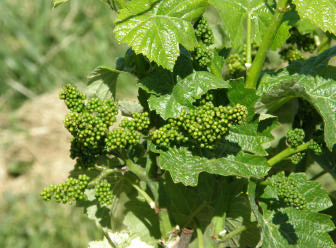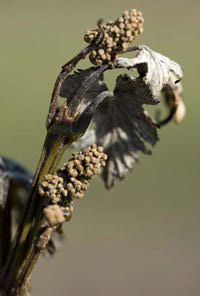Anderson Valley: Hot & Cold But Cool
In the middle of May I found myself cruising north along Interstate Highway 101 heading for the 11th Annual Anderson
Valley Pinot Noir Festival sponsored by the Anderson Valley Winegrower’s Association. As I turned west on
Highway 128 for the winding and scenic 40 minute drive to the bucolic Anderson Valley, I noted a significant
rise in temperature. By the time I had reached Boonville, it was nearly 100°F! The heat spell, which was to continue
all weekend, was a shock to the locals. Anderson Valley is classified as a Region I viticulture area in the
lower or more northerly part of the valley, and Region II in the upper valley around Boonville according to the
heat summation classification developed by two University of California Davis professors, Albert Winkler and
Maynard Amerine. The classification is based on heat summation, that is, the number of units of heat or
“degree-days” available to ripen grapes. The heat units are determined by the length in days and the average
daily temperature. Region I has less than 2.500 heat units, and Region II, 2,5001 to 3,500 heat units. Other wine
growing areas designated as Region I are Carneros, Santa Cruz Mountains, Santa Maria Valley, Burgundy and
Champagne. Edna Valley and the Russian River Valley are Region II areas. Cool-climate varieties such as Pinot
Noir are right at home in Regions I and II.
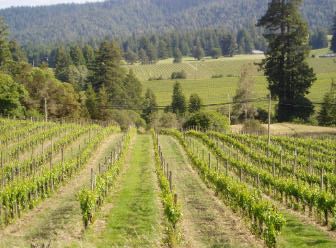
The heat wave in May was inopportune for it had been
preceded in April by two weeks of frosts. The April cold
snap affected most parts of Northern California, but the
Anderson Valley was hit especially hard. Many veteran
winegrowers said that it was the worst series of frosts
since the early 1970s. The photo on page 2 from Inman
Family Olivet Grange Vineyard in the Russian River
Valley illustrates the damage that frost can do to young
shoots (photo on left is normal bud growth at Goldeneye
Confluence Vineyard, photo on right is damaged shoot).
Early budding varieties, such as Pinot Noir, are especially
vulnerable to frost damage. Fred Buonanno,
owner of Philo Ridge Vineyards in the Anderson Valley,
said that although his vineyard is located at 1,200 feet, he
lost 70 percent of his Pinot Noir and 90 percent of his Pinot
Gris. In talking with growers in the Anderson Valley
during my trip, they spoke of some vineyards being spared and others suffering 80 percent or more loss of bud
growth. The searing heat wave that followed in May in Northern California created a jolt in
weather conditions that further stressed the vines. In general, vines prefer gradual changes in temperature.
Both frost and extreme heat kill the flowers on the young shoots that must be pollinated to develop into grapes.
A grapevine has three growth points or buds (primary, secondary, tertiary). The primary buds develop first
and produce the largest and most desirable crop. If damaged, the secondary or tertiary buds may develop into grapes, but the net result will be that grape quantity, but not quality, will be reduced.
There are a few active methods that growers use to deal with frost. Fans or helicopters can mix the
warm air above with the layer of cold air close to the ground helping to prevent frost from settling on
vines. Overhead sprinklers or microsprayers can provide a protective coating of water that insulates
vines from damage (the action of the liquid turning to a solid actually puts off heat in the process,
keeping the tender shoots safe). Heaters accomplish the same result.
The Anderson Valley received appellation status in 1983 and among eleven grape-growing appellations
in Mendocino County, is uniquely suited to growing Pinot Noir. The latest data from Glenn
McGourty, a winegrowing and plant science advisor for Mendocino County, shows that there are 1,128
acres of Pinot Noir in Anderson Valley, 383 acres in Potter Valley, 154 acres in Redwood Valley, 69
acres in Ukiah Valley, and 49 acres in Yorkville Highlands. Total vineyard acreage for all varieties in
Anderson Valley is 2,200 acres.
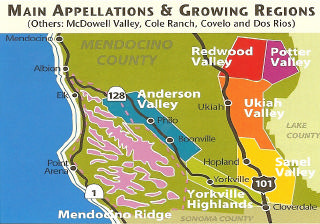
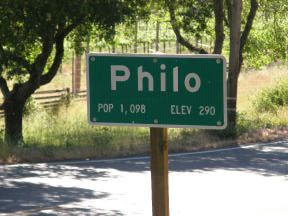
The Anderson Valley is a relatively isolated, small and narrow valley, ½ to 1½ miles
wide, and 16 miles wide. It is bordered on three sides by 2,000 to 3,000 foot mountains and is only 18
miles from the Pacific Ocean at its northern tip or “deep end.” The valley opens on its northern end to
the Pacific coast via the Navarro River Canyon and this unique topography allows fog to roll into the
valley in the early morning and gentle, cooling
breezes to enter in the afternoon. A gradient is
thereby created, with the northern ocean end, referred
to by locals as “down-valley,” receiving more rain and
fog and thus cooler, and the southern inland portion, or
“upper-valley,” being typically 8-10°F warmer. The
valley’s vineyards and wineries are clustered along
the fringes of Highway 128, which bisects the valley,
with a majority of them located down-valley. Along
Highway 128, the vineyards begin at the town of Boonville,
continue north through Philo, and end in the tiniest
hamlet of the three, Navarro, population 67. As it
continues north, Highway 128 winds through redwood
forests, eventually reaching the town of Mendocino
and the Pacific Ocean. The latest map of Anderson Valley published by the Anderson Valley Winegrowers
Association (www.avwines.com) is on page 4.
To visit Anderson Valley is to leave the world of roadside McDonalds, convenience stores, and Starbucks
behind and encounter a pastoral countryside teaming with moss-covered majestic oaks, manzanitas,
ramshackle old barns, and grassy meadows with calmly grazing sheep and cows. Boonville is
the center of “activity” in the valley. About 3,000 people are scattered throughout the valley, a fourth
of them calling Boonville home.
Boonville is known as Boont in the local language of Anderson Valley called boontling. In the 1800s,
this original code-like dialect became the spoken word for many of the valley residents. The exact
origins are unclear, but many attribute the beginnings to the mothers and children who worked in the
hop fields prevalent in the valley at the time. The isolation of the valley and the distrust of city people
(“brightlighters”) fostered the language. Terms included “baul seep” - lovers of wine, “baul hornin” -
good drinking, “Frati” - wine (Mr Frati was a local vineyard owner), “Frati shams” - wine grapes,
“breggo” - sheep, and “backdated chuck” - someone who is behind the times. Many of the words had
their origins in the languages of the Scottish, Irish, Spanish, and Pomo Indians who settled in the valley.
Today, fragments of boontling remain as slang terms and the locals still have a cautious distrust of city
people. If you visit, avoid incurring the wrath of locals by appearing to be a raging “brightlighter.”
Leave your designer jeans, Louis Vitton bags, and Polo shirts at home.
The Pomo tribe were the original Native American inhabitants of Anderson Valley. Among the first
white settlers were the Anderson family in 1851. Walter Anderson planted the first apple trees in the
valley. Soon, other crops such as pears and hops were ubiquitous, and a thriving timber industry developed.
The 1960s brought an influx of hippies drawn to the beauty and isolation of the valley. During
the 1970s and 1980s, urban refugees bought ranches and replaced apple and pear orchards with
vineyards. The latest newcomers to the valley are Mexican laborers valued for their work in the vineyards.
Olives are the newest crop and several olive oil producers have appeared including the well-regarded
Stella Cadente. Anderson Valley’s largest crop in revenue (including grapes) is marijuana.
If you visit, and are searching for vineyards off the main highway, proceed with extreme caution as you
may receive a volley of buckshot as a reward for your inquisitiveness.
In the late 1800s, small vineyards began to be planted in the valley. After 1900, Italian settlers came to
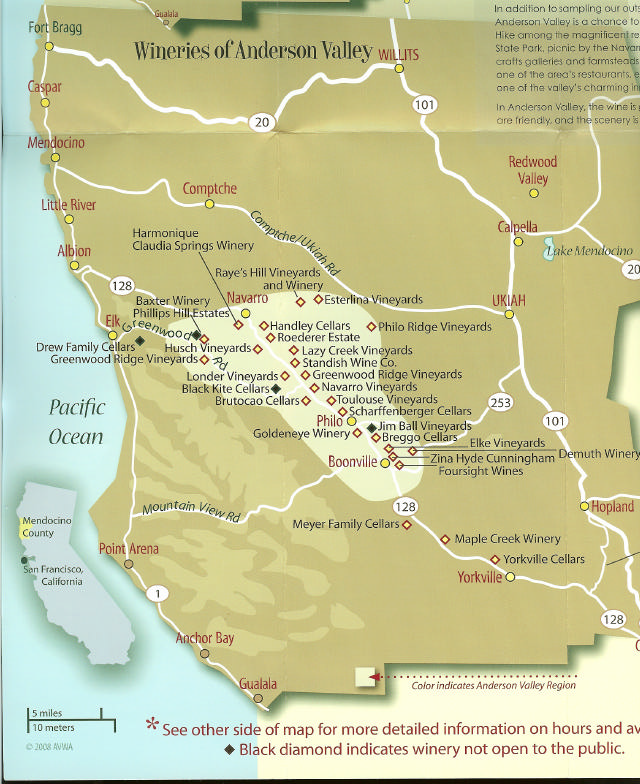
Mendocino from San Francisco and had success growing grapes above the valley floor along the
Greenwood Ridge. Today, some of these original Zinfandel vineyards still survive. After Prohibition,
attempts to grow grapes in the valley by Asti, Goodhue, and Pinoli were largely unsuccessful because
of poor choice of varieties and problems with ripeness and frosts. The modern history of winegrowing
in the Anderson Valley is linked to four winery names: Edmeades, Husch, Lazy Creek, and Navarro. In
1963, Dr. Donald Edmeades, a Pasadena, California cardiologist, purchased land north of Philo and
planted 24 acres of grapes. The locals were quite skeptical, and Edmeades, in good humor, put up a
sign on Highway 128 that read “Edmeades’ Folly.” He had, in fact, carefully researched the potential
for premium grape growing in the valley beforehand. Edmeades had success growing Chardonnay
and Gewürztraminer, but unfortunately, he passed away from cancer just after his winery was built in
1972. His son Deron took over and made the first vintage. Edmeades (now part of Kendall-Jackson
Estates and closed to the public) has achieved notoriety with Zinfandel grown in Mendocino County.
Edmeades was never a major player in the Pinot Noir game.
The first Pinot Noir planted in the Anderson Valley was by Wilton (Tony) Husch in 1968. Husch had
been exposed to Pinot Noir by John Parducci who was a pioneering winegrower in Mendocino County
dating back to 1931. A 3-acre parcel of the Husch's property known as the Knoll was chosen. Located on a hillside
overlooking the Navarro River, the Knoll vineyard was planted to a Wente field selection of Pinot
Noir. The first harvest was in 1971. Long-time vineyard manager, Al White, arrived in 1973, two years
after Husch Vineyards became a bonded winery in Anderson Valley. As White recounts his first harvest
at Husch in 1974, one is struck by the archaic vineyard management of the time. The vines were
planted with 8 ft by 12 ft spacing with overhead irrigation. Trellising was minimal and no leaf pulling
was done. Rain at harvest was a problem and with it came mold which was a significant nuisance. The
grapes were picked into apple boxes at a very casual pace over several days by a hippie crew. The
Knoll Vineyard is still producing Pinot Noir, but has been transformed by more modern viticulture
practices. Husch Vineyards was sold to the Oswald family in 1979 and is currently under new ownership
(see page 27).
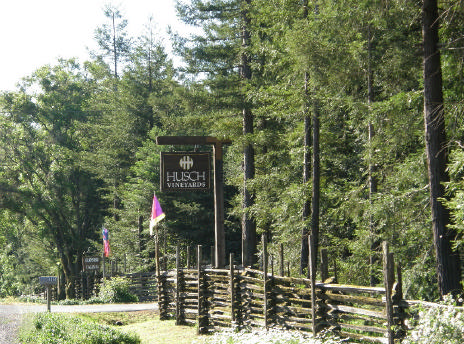
The Greenwood Ridge Vineyard was planted by Tony Husch in 1972 in Mendocino Ridge, an area originally settled by Italian immigrants. Allen Green acquired the vineyard in 1973 and bonded his Greenwood Ridge
Winery, located on Highway 128, in 1980. Greenwood Ridge has been the site of the California Wine
Tasting Championships ever since 1983.
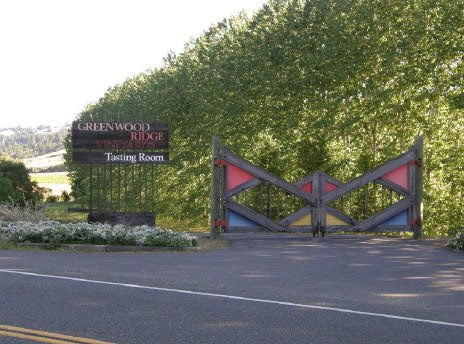
Johann Kobler, a San Francisco restaurateur, and his wife Theresia, purchased the 20-acre Lazy Creek
Vineyards in 1969 from the Pinoli family. The Pinolis has farmed the land in Philo since the early
1900s. Pinoli was the first bonded winery in the valley (1911). The Pinolis showed that grapes could
ripen here, but they had much more success with their fruit orchards than the vineyards. Kobler was
able to revitalize the vineyards, built a small winery (1973), and subsequently became quite successful
with both Pinot Noir and Gewürztraminer. Lazy Creek was purchased by Josh and Mary Beth Chandler
in 1999, and they have carried on the tradition respectably.
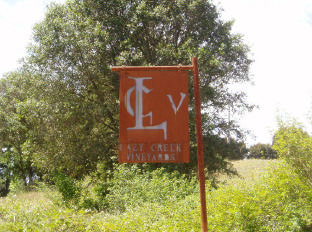
Ted Bennett was a successful businessman when he and his wife, Deborah Cahn, left San Francisco in
1973 and purchased a 900-acre sheep ranch along Highway 128 between Philo and Navarro. They
were Alsatian grape aficionados and planted only white varietals when they began in 1974. Pinot
Noir came later, and today they have 31 acres of estate Pinot Noir and source additional quantities
from other Anderson Valley vineyards. It was largely their marketing sense that put Anderson Valley
in the minds of wine enthusiasts and brought notoriety to the wines of this region. They built an attractive
tasting room and sent out a very informative newsletter that led to considerable consumer-direct
sales and buyer loyalty. Today, their lineup of quality wines is impressive including Gewürztraminer,
Riesling, Sauvignon Blanc, Pinot Gris, Muscat, Zinfandel, Syrah, and Pinot Noir (three bottlings including
Anderson Valley, Mèthode a l’Ancienne, and Deep End Blend).
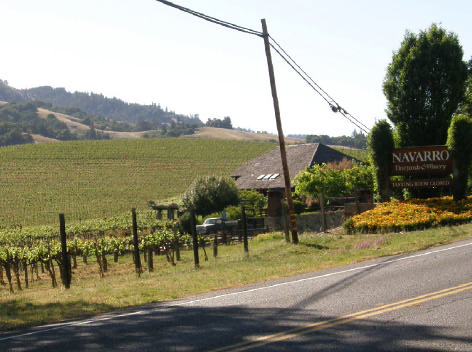
Today, there are 27 wineries and more than 60 vineyards in the Anderson Valley. Some of the vineyard
names have become household words to pinophiles: Cerise, Demuth, Donnelly Creek, Ferrington,
Hacienda Secoya, Hein Family, Klindt, Morning Dew Ranch, Savoy, Toulouse, and Wiley. At least
28 major California Pinot Noir producers access grapes from Anderson Valley (Anthill Farms, Arista
Winery, Adrian Fog, Barnett, Benovia, Brogan Cellars, Cakebread Cellars, Copain Wines, Couloir
Wines, Dain Wines, Ferrari-Carano Vineyards and Winery, Fulcrum Wines, Gryphon Wines, Hartford
Family Wines, Harrington, Ici/La-Bas, La Crema Winery, Littorai, MacPhail Family Wines, Madrigal
Vineyards, Radio-Coteau, Roessler Cellars, Saintsbury, Skewis, Whitcraft, Whitethorn, Williams-
Selyem, and Woodenhead Vintners). Most of the vineyards are less than 10 acres, with three large
growers, Roederer Estate, Goldeneye, and Navarro controlling the most total acreage. Pinot Noir
acreage has dramatically increased since 1997, and now accounts for more than 50 percent of Anderson
Valley’s planted vineyard acreage (see graph displayed at the Anderson Valley Pinot Noir Festival
Technical Conference by Glen McGourty showing the increase in Pinot Noir plantings in California
and Mendocino, 1997-2005, page 8). Despite the desirability and quality of Pinot Noir grapes from
Anderson Valley, the average price per ton still lags other prominent California AVAs. The latest figures:
Santa Barbara County - $2,918 per ton, Sonoma County - $2,826 per ton, Napa County - $2,412
per ton, Mendocino County - $2,348 per ton, and Monterey County - $1,806 per ton. However, Pinot
Noirs grapes from prestigious Anderson Valley vineyards can command up to $6,000 per ton.
